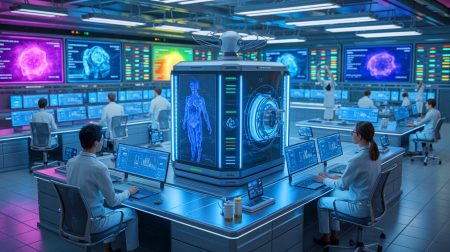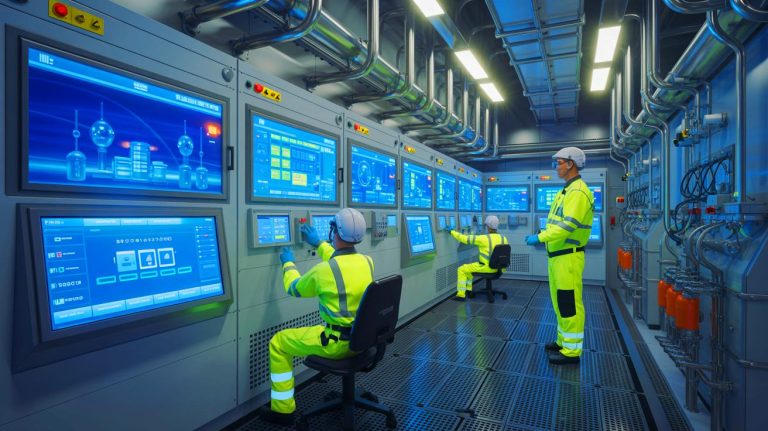| IN A NUTSHELL |
|
The groundbreaking launch of the world’s first fully integrated hydrogen production simulator within a Small Modular Reactor (SMR) control room is a significant milestone in the clean energy landscape. Hosted by NuScale Power Corporation in collaboration with GSE Solutions, this innovation marks a new era in demonstrating the potential of nuclear-powered high-temperature steam electrolysis for scalable, carbon-free hydrogen production. As the world grapples with climate change and seeks sustainable energy solutions, this development could redefine the boundaries of nuclear energy, positioning it as a cornerstone in a diversified and resilient energy economy.
The Role of Reversible Solid Oxide Fuel Cells
At the heart of this innovative architecture are Reversible Solid Oxide Fuel Cells (RSOFCs), a dual-function technology capable of generating electricity, hydrogen, and clean water simultaneously. This capability positions NuScale’s SMR ecosystem as a versatile energy solution, addressing critical issues like industrial decarbonization, water scarcity, and clean molecule synthesis through a single platform. Far from being just a conceptual model, the simulator operates in real time, replicating complete thermal and process interactions between SMRs and hydrogen production systems.
Moreover, the deployment serves a dual purpose: system validation and workforce development. NuScale plans to expand simulator access to academic and industry partners, supporting operator training and curriculum development. This strategy effectively creates a pipeline of skilled personnel capable of managing integrated nuclear-hydrogen platforms, which will be essential as SMRs transition from grid-only assets to multi-vector energy producers. The integration of such sophisticated training environments with nuclear technologies is unprecedented in the hydrogen sector.
SMRs: Beyond Electricity
NuScale’s simulator underscores a pivotal shift: using SMRs not just for electricity but as central assets in hydrogen and clean fuel economies. While intermittent renewables have traditionally dominated green hydrogen production, SMRs offer a consistent thermal and electrical input crucial for high-temperature electrolysis systems that require stable operational baselines. By leveraging nuclear’s baseload profile, NuScale aims to anchor a more resilient and modular hydrogen production infrastructure.
The system’s modularity and transportability align with emerging global needs for decentralized, low-carbon industrial solutions. This development follows NuScale’s prior announcements on expanding SMR applications, including desalination and hydrogen production. Earlier research highlighted how a single NuScale Power Module (NPM) could generate 150 million gallons of clean water daily through reverse osmosis, without emissions. In multi-module configurations, 12 NPMs could supply clean water to 2.3 million people while providing electricity to 400,000 homes.
Innovations in Desalination and Hydrogen Production
A critical innovation in NuScale’s system is the reuse of desalination brine. In partnership with the US Department of Energy’s Pacific Northwest National Laboratory, NuScale is advancing a hydrothermal chemical process that converts brine into hydrogen feedstock. This method significantly reduces the need for conventional electrolysis, lowering both energy and freshwater consumption. The closed-loop approach offers an eco-friendly solution by reducing salty waste and producing hydrogen without carbon emissions.
This innovative strategy illustrates NuScale’s commitment to addressing global challenges in water scarcity and clean energy. By integrating SMRs with hydrogen production, desalination, and brine utilization, the company positions itself at the nexus of water, energy, and industrial sustainability. Dr. José Reyes, NuScale’s CTO, aptly describes the initiative as a “win-win-win” for global sustainability challenges.
Europe’s Economic Rebound Stalls as U.S. Tariffs Cast a Shadow
Navigating the Future of Clean Energy
NuScale’s simulator project signals a larger vision to transform how nuclear energy contributes to the global clean energy transition. The initiative integrates cutting-edge nuclear technology with hydrogen production, offering a sustainable and scalable approach to energy generation. As the world shifts towards cleaner energy solutions, such innovations will be crucial in meeting increasing energy demands while minimizing environmental impact.
As we stand on the brink of a new era in energy production, the question remains: How will further technological advancements in nuclear and hydrogen production reshape our approach to global energy sustainability?
Did you like it? 4.5/5 (22)








Wow, this is like something out of a sci-fi movie! 🚀
Can this technology be scaled up for larger reactors, or is it limited to SMRs?
What are the potential risks of integrating hydrogen production with nuclear reactors? 🤔
Finally, a step towards cleaner energy! Thank you, NuScale! 🌿
How does this affect the cost of hydrogen compared to traditional methods?
I’m a little skeptical. How safe is this new technology really?